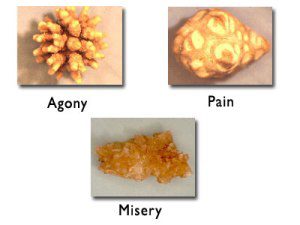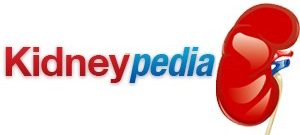
Kidney stones are masses of crystallized mineral that precipitate in urine as it is passing through the urinary system –
In most cases, a kidney stone will be washed out of the body with urine, naturally and without any need for medical intervention. This is known as “passing” the kidney stone. Only the largest stones require active intervention in the form of lithotripsy (various methods of breaking the stone into smaller fragments) or lithotomy (surgical removal of the stone). The main problem is managing the pain until the stone passes and monitoring the condition to make sure that no more direct intervention is required.
Process
Passing a kidney stone is simply a matter of moving it through the urinary channels until it enters the bladder. Unless it’s a really enormous stone, it won’t present any problem after that. The mechanism for doing this is entirely natural. It’s contained in the tiny involuntary muscles that power the motion of urine through the system. These muscles are contained in the walls of the urinary channels or ureters which fill the kidneys. Their motion is called peristalsis.
The problem is that a stone can be large enough to get wedged into a ureter. When that happens, it stretches and stresses the wall of the ureter as it moves. This is what produces the painful sensation, which often pulses in time with the waves of peristalsis. As long as the stone continues to move through the channel, though, it will eventually pass out of the body. When it becomes large enough to wedge tightly into the channel so that it can’t move at all, then direct intervention is called for.
Pain Management
If you have signs of a kidney stone, it’s very important to see a doctor. Although in most cases the doctor won’t do anything beyond prescribing pain medication and monitoring your condition, if you have a kidney stone that requires intervention it’s important to get it. The advice in this article is not a substitute for proper medical advice.
The pain from a kidney stone at its worst has been described as among the most severe forms of acute pain a human body can suffer. It is however amenable to treatment. Here are some of the better ways to treat kidney stone pain without a prescription for opioid drugs.
Tips
The first line of defense is simply acetaminophen (Tylenol). Possibly better than this is ibuprofen, which is a non-
A warm bath can also be an effective pain reliever for kidney stones. The same effect can be obtained with a heating pad applied to the lower back, right over the part that hurts.
Home Remedies
A number of traditional remedies exist for kidney stones. These include lemon juice, pomegranate juice, horsetail (a diuretic), dandelion root, and uva ursi. Always consult the literature and studies done before using herbal remedies; it’s a common misconception that such remedies have no side effects, but they are, in fact, drugs and should be treated with appropriate caution.
Home remedies are definitely worth a try, however. They should not be regarded as a substitute for medical attention, but as noted above, unless you have a very large stone a doctor is unlikely to do more than monitor your condition and treat you for the pain. In most cases, that’s all that’s required, but any help you can give your body in passing the stone (and ending the pain) is surely a good thing.
